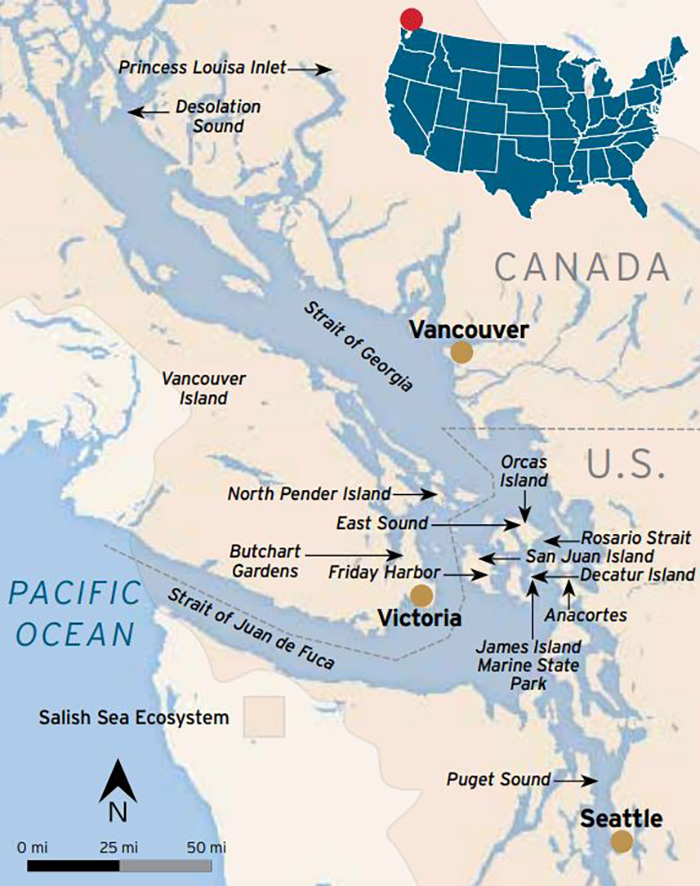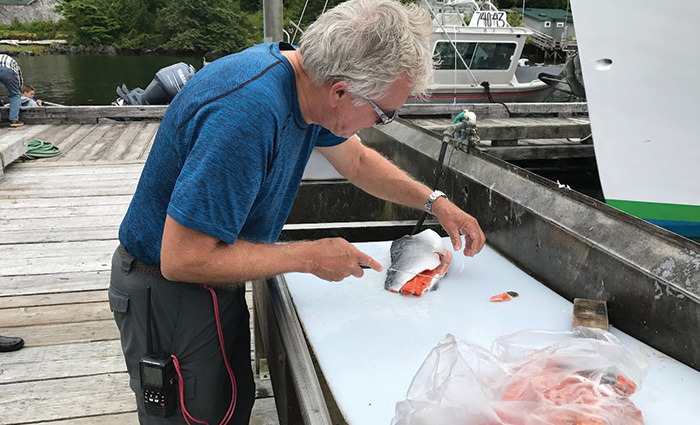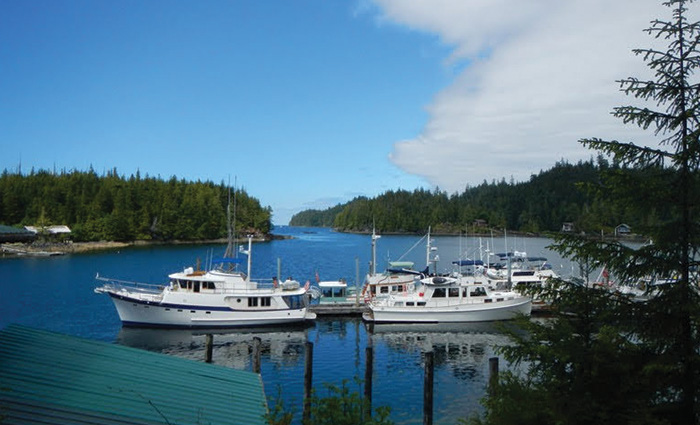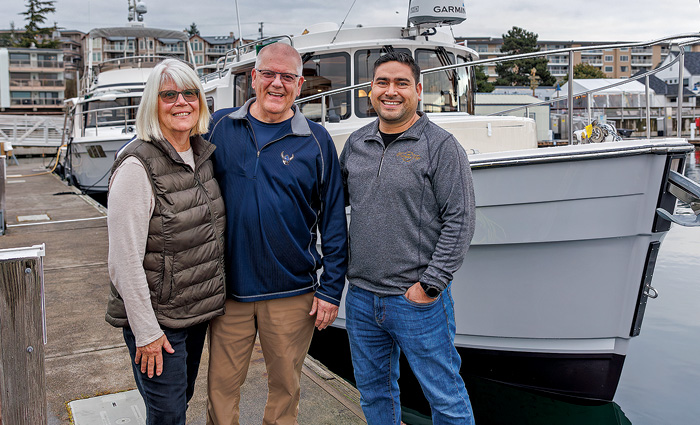Advertisement
In the heart of the Pacific Northwest lies the Salish Sea, a maritime wonderland beckoning adventurous souls to explore its pristine waters by boat. Encompassing a labyrinth of inlets, fjords, and secluded coves, this nautical haven offers a tapestry of marine life, captivating scenery, and maritime history that seamlessly blends with the spirit of today’s seafaring enthusiasts. From the tranquil waters of Puget Sound to the rugged beauty of the San Juan Islands, the waters of the Pacific Northwest are an idyllic playground for those seeking a West Coast boating escapade.
The Strait of Juan De Fuca divides Washington from Canada’s Vancouver Island and connects the Salish Sea to the Pacific Ocean 60 miles west. Islands and peninsulas cover more than 1,000 square miles within that protected inland sea. Rocky shorelines are surrounded by flowing waters that drop to astounding depths. More than a trillion gallons of water move through during each tide, refreshing the sea every day and providing nutrients and habitat for aquatic life. Pods of endangered orcas, sea lions, seals, otters, porpoise, and other marine mammals thrive here. Rare sea birds like tufted puffins bob on the emerald-green surface while osprey and stately bald eagles soar overhead carrying fish in their talons.
Giant Pacific octopus, the largest in the world, hide in the deep rocky crags and mingle with crabs and bottom fish. Salmon of all types, including chinook, king of all salmon, feed among the islands and spawn in connecting rivers. There, habitat restoration is underway including removing dams to help revitalize their population. Historically, these magnificent fish once weighed over 100 pounds each; most king salmon today are less than 25 pounds. Chinook are the primary food source for resident orcas, a culturally significant resource to local indigenous people, and prized by anglers.

Crossing into Canada
If you plan to include Canada on your trip, familiarize yourself with Canadian and U.S. entry requirements for pleasure boats (cbsa-asfc.gc.ca/travel-voyage/pb-pp-eng.html). For re-entry into the U.S., download the CPB Roam app on your smartphone for easier customs and immigration processing (cbp.gov/travel/pleasure-boats/pleasure-boat-overview/roam).
If you’re not a U.S. citizen, be aware that there are regulations about who can operate U.S.-flagged vessels. — A.H.
Year-round boating
People associate Seattle with rain and, while it can be rainy, the biggest difference in weather from your home cruising area is probably temperature. It rarely gets hot at 48 North, but if you want to escape extreme summer heat, you’ll enjoy the cool Northwest waters. While it occasionally peaks in the 80s and 90s, average summer daytime temperatures are usually in the mid-70s; at night it drops to the 60s or lower. Temperatures are pleasant, especially for sleeping. Air conditioning is rarely needed, and most boats have heat for off-season cruising.
One reason air temperatures are mild is the tremendous depth of seawater, where temperatures even at their warmest never reach 60 F. An exception is Desolation Sound, which lies in a tidal convergence zone. The reduced movement allows the sun to warm the waters more effectively, so that’s one of the few places you’ll see lots of swimming. All around the Salish Sea, kayaks, stand-up paddleboards, and wading along the beach are common ways to enjoy the water without complete immersion.
Summer days are long – 5 a.m. to 9 p.m., plus twilight for all of July! – giving more time to be on the water with activities often stretching into the evenings. You can boat year-round in Puget Sound, and charter rates are considerably cheaper in the off-season. Weather can be more challenging, and some destinations are limited, but properly planned off-season trips are a great way to escape the crowds and appreciate the natural beauty. Rain tends to be more drizzle than deluge, and if you’re superstitious about umbrellas onboard, don’t worry. Locals never use them, preferring to face the weather head-on.
Must-see ports of call Aside from the straits, most of the area is surrounded by land, making the Salish Sea an ideal cruising area even for smaller vessels. Numerous gunkholing spots and pristine anchorages offer quiet getaways on the hook. For more action, there are a wide variety of marinas and resorts to choose from, all with different amenities and conveniences, plus state parks, some with mooring buoys. Whether you seek serenity, camaraderie, or a combination of both, here’s a sampling of cruising destinations to consider on your cruise or charter.

Filleting the day’s catch. Wild-caught Pacific sockeye and king salmon are staples in the Northwest. Photo: right: NW Explorations
James Island Marine State Park
This small island adjacent to Decatur Island on the west side of Rosario Strait is only 8 miles from Anacortes and makes a great first or last stop when cruising the San Juan Islands. The park is only accessible by boat and has two anchorages separated by a narrow isthmus, both with sandy beaches – a rarity in the islands as many beaches are rocky. Both anchorages offer moorings on a first come, first served basis. There’s a 128-foot dock in West Cove. A good portion of the island is Natural Forest Area (closed to the public), but the bays have primitive campsites and there are a few miles of moderately steep trails that lead to viewpoints. | parks.wa.gov/522/James-Island
Orcas Island/ Rosario Resort
Halfway up East Sound on Orcas Island is Rosario Resort, complete with its historic mansion built from massive old-growth lumber with carved details giving it the look of a classic yacht. The marina has 30 slips, an outdoor pool, and restaurant. Robert Moran, a Seattle mayor and shipbuilder, constructed the mansion in 1906. Today it contains a hotel, day spa, small museum, bar, and fine dining restaurant. Marina guests can pay extra for admission to the adult-only outdoor pool on a bluff overlooking the Sound or the indoor pool in the heart of the mansion. The museum showcases the house and Moran shipbuilding, including model warships. The music room houses a 1913 Aeolian pipe organ with 1,972 pipes covering the walls. Plan your visit around music performances, photographs, and silent films to see and hear the organ and a vintage 1900 Steinway piano. | rosarioresort.com
San Juan Island/Friday Harbor
Friday Harbor is the biggest city on San Juan Island, with numerous restaurants, shops, and boutiques, grocery, and a hardware store. The marina has slips from 20- to 80-plus feet; the fuel dock has the lowest fuel prices in the islands, and offers fuel discounts for BoatU.S. members (BoatUS.com/Maps). Friday Harbor Seafood is a complete seafood store on a floating dock in the marina where you can buy fresh crabs, oysters, spot prawns, and other seafood. For a shoreside adventure, try an island bus tour or rent a scooter from Susie’s Mopeds. Cattle Point Lighthouse provides sweeping views of the straits and Olympic mountains, and Lime Kiln Point State Park has a viewpoint from where you may see passing resident orcas. | portfridayharbor.org
San Juan Island/ Roche Harbor Resort
A favorite stop, this former company town is now a resort. The historic Hotel De Haro at the head of the docks has been operating since 1886. Their docks service boats up to 100-plus feet. Amenities include fuel, seafood, groceries, marine supplies, restaurants, spa, espresso, ice cream, pool, bocce, tennis courts, boutiques, and artisan stands. There’s a small general aviation airport at the top of the hill and sea plane service at the docks. Easy hiking trails include one that leads up through the lime quarries to a hill where you can see across to Canada. Another heads through deer-filled woods to a pillared mausoleum. The stone table and chairs is a memorial to the McMillin family who founded Roche Harbor. A large, protected anchorage is great for those who want to anchor; you can dinghy ashore to explore the resort. | rocheharbor.com

Photo: NW Explorations
Stuart Island Marine State Park
Only accessible by boat, Stuart Island is the last stop before heading into Canada. There are two harbors, Reed and Prevost, separated by an isthmus with 20 mooring buoys, 448 feet of dock space, a pumpout station, and substantial room to anchor. Hikers can seek higher ground, exit the park, and head to the Turn Point Light Station to watch ships heading up Boundary Pass to the Strait of Georgia and the city of Vancouver. This quiet spot is a great place to relax or catch some fish or local Dungeness crab. | parks.wa.gov/593/Stuart-Island
Pender Island/Bedwell Harbor, Poet’s Cove Resort
The gateway to the Gulf Islands, you can clear Canadian Customs in Bedwell Harbor. Once cleared, the adjacent Poet’s Cove resort is a great place to stay with 110 slips. Ashore, the hotel and resort features a pub/restaurant, two swimming pools with hot tubs, a convenience store with ice cream, and espresso stand. The spa, which closed in 2023, is expected to reopen this year. | poetscove.com
Butchart Gardens and Brentwood Bay Resort
One of our favorite stops is Butchart Gardens, a 100-year-old Canadian National Historic Site where Jennie Butchart turned an abandoned rock quarry into a series of spectacular gardens. The volume of flowers and colors is breathtaking. Attractions include restaurants, a carousel, gelato stand, and concerts on the lawn, sometimes with fireworks. Dinghy over from nearby Brentwood Bay Marina or from the anchorage in Tod Inlet to a dock entrance only for boaters. The gardens are magnificent, and Brentwood Bay Resort has a good pub/restaurant and an adult-only pool with a hot tub. Tod Inlet is well-protected, has good holding, and you can see the fireworks from your boat depending on where you anchor. | butchartgardens.com

Photo: Fluid Motion
Factory delivery experience
If you’re purchasing a new boat from a Northwest boatbuilder, some offer factory delivery options that allow you to explore the Salish Sea aboard your new boat before it’s shipped to your homeport. Ranger Tugs and Cutwater Boats pioneered this with their Factory Delivery Experience program. The companies have an operations base out of a marina in Des Moines, Washington, a few miles from Seatac airport.
Take predelivery of your new boat in Puget Sound, receive a boat briefing on the boat’s systems and operations, then practice docking, launching, and retrieving trailerable models with factory personnel and ensure your electronics are set up for your trip. Then cruise Puget Sound and even head to Canada for an epic shakedown. After your trip, the factory packs up your boat and ships it home for you. Time your trip to join members of the factory team and other Ranger/Cutwater owners on some flotilla-like cruises, or head to one of the largest owner’s rendezvous in the country held in Roche Harbor, San Juan Island, every September. | rangertugs.com/why-ranger-tugs/factory-delivery or cutwaterboats.com/why-cutwater/factory-delivery — A.H.
Chartering the Pacific Northwest
Several established charter companies in Anacortes and Bellingham offer a wide variety of boats
Anacortes Yacht Charters
In business since 1979, AYC has the largest fleet of powerboats and a good selection of sailboats ranging from 27 feet to over 50. Sailboats include Beneteau, Jenneau, Catalina, and a few catamarans. Prices are $500 to $1,000 per day depending on season, size, and boat model, plus fuel, tax, and insurance. AYC powerboats feature Ranger Tugs, Grand Banks, and Ocean Alexander. Powerboat prices vary; smaller boats are similarly priced to sailboats, and larger powerboats start at $1,500 to $2,000 or more per day.
If you’re considering a future boat purchase, AYC’s large fleet means it may have a similar model you can try out on your charter adventure. If you want to learn to sail, switch from sail to power, single to twin engines, or move up to a bigger boat, AYC offers classes to help. While specializing in bareboat charters, it has captains available as well as a “cruise-and-learn” program where you can fine-tune your docking, anchoring, and navigation skills. The San Juan Islands are only 8 miles from AYC’s base in Anacortes, which lets you get to the cruising grounds quickly. | anacortesyachtcharters.com
San Juan Sailing & Yachting
Based in Bellingham, SJS&Y has a large fleet of sail- and powerboats. If you’ve chartered a cat in the BVI, you know these boats combine comfortable on-deck living spaces with the privacy of sleeping cabins at separate ends of the hulls. SJS&Y has a half-dozen cat options as well as more than 35 monohulls featuring Jenneau, Bavaria, and Beneteau brands. Charters are based on six nights/seven days and typically run 9 a.m. Saturday until noon Friday. Cats range from around $1,000 to $1,800 per day, monohulls around $500 to $1,000-plus a day. Rates vary by boat and season, and insurance adds $100–$150 per day. The powerboat fleet offers boats from 31 feet to 55 feet including trawlers and some tug-style boats from American, Nordic, and Ranger. Powerboat rates start around $500/day to $1,700/day for larger boats during high season.
SJS&Y also offers American Sailing Association (ASA)- and American Powerboat Association (APBA)-affiliated classes to help you learn to sail, hone boating skills including docking and anchoring, or learn how to run different types of boats. It also offers flotillas where groups of boats cruise along with a leader who plans the trip and activities, including raft-ups, happy hours, potlucks, and shoreside excursions. | sanjuansailing.com
NW Explorations
NWE is a powerboat-only charter operation with a fleet ranging from 42- to 70 feet including a dozen Grand Banks models and other large, quality cruisers from Ocean Alexander, Kadey Krogen, Nordhavn, and Hampton Yachts. NWE also specializes in flotilla adventures, some of which go as far as Alaska, which you can book individual “legs” either way, or explore Desolation Sound or Princess Louisa Inlet, two of Canada’s premier cruising destinations. Weekly rates for most of their Grand Banks fleet range from $850 to $1,500 per day; larger, fancier boats run $2,000 to $3,000/day in-season. NWE is based in Bellingham, an easy hop across to the San Juan Islands and into Canada. For non-U.S. citizens and those interested in cruising only in Canada, NWE has a sister operation in British Columbia, Cooper Boating (cooperboating.com), that offers both sail- and powerboats based out of several Canadian locations. | nwexplorations.com
Seattle Yachts Sailing Academy
While not technically a charter company, this ASA-affiliated Sailtime sailing school and club in Anacortes offers sailing lessons and educational cruises on two Hanse 35- to 39-foot sailboats. The academy teaches standard ASA classes like Basic Keelboat, Coastal Cruising, and Bareboat Cruising, including onboard overnight instruction. For single cruisers, small groups, or adventurous couples, these programs can be one of the most affordable ways to sail and see Puget Sound. You share the boat with other students and an instructor; the three-day, two-night cruise is $950 per person including food and instruction; five days and four nights is $1,895 each. Sailtime has many locations throughout the U.S., so you can start your instruction and get your basic sailing courses done close to home. Then come to the Pacific Northwest for a cruise, finish your bareboat certification, and charter on your own. SYSA plans to add a catamaran to teach the nuances of cat sailing and cruising. |
sailtime.com/location/anacortes/sailing-school — A.H.

